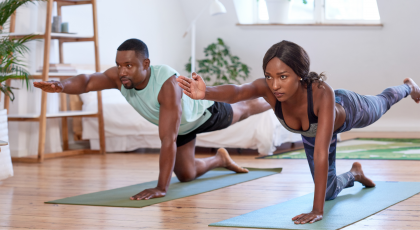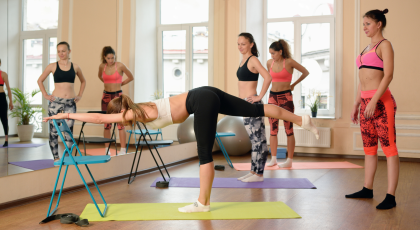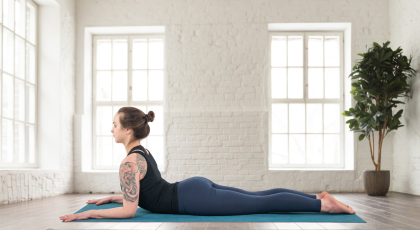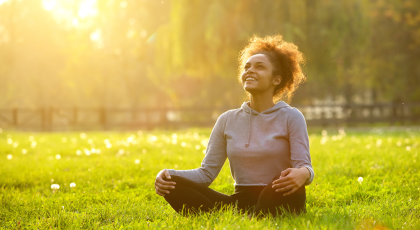View basket (0 items $0.00)
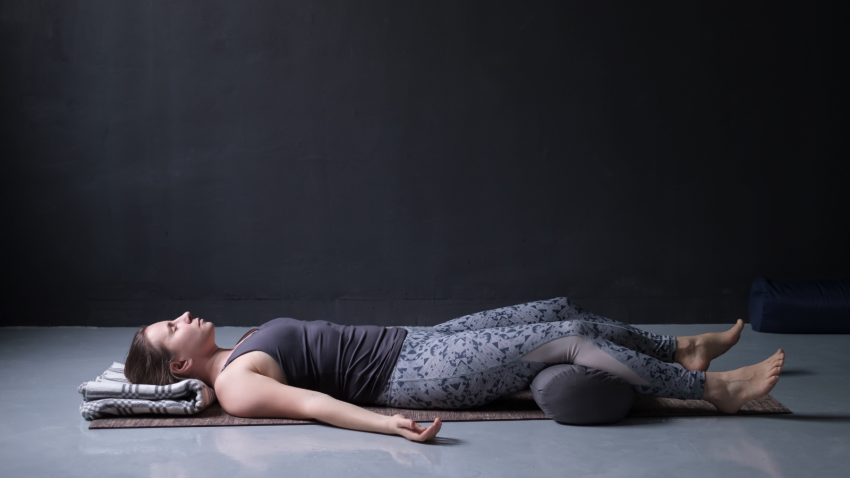
4 Yogic Tips to Make your New Year's Resolutions Stick
It's the start of a new year, and that means new New Year resolutions! In this article, YogaUOnline teacher Kristine Kaoverii Weber, founder of Subtle Yoga, offers some great tips and action steps to help us keep those resolutions, including 6 good habits to cultivate for a healthier lifestyle.
"Every year I try to eat better,” a yoga student Jen, told me in a frustration-tinged tone, “And I do really well for a while, but then I start to notice, around the end of February, that my old habits have come back and I’m eating candy bars again every day. I just don’t know how to make it stick.”
Habits, whether good, bad, or neutral, comprise much of our daily activity. Brushing your teeth, meditating, and taking a shower are all habitual activities. But so is eating junk food, biting your nails, negative self-talk, and spending too much time on Facebook.
How do you make New Year’s Resolutions stick? Whether you’re trying to lose weight, quit smoking, stop eating sugar, or just trying to get to bed earlier here are some yoga ideas about employing the power of yoga and making it work for you so that your New Year’s Resolutions actually become healthy habits.
1. The Yoga Tradition of Satsaunga (Keeping Good Company)
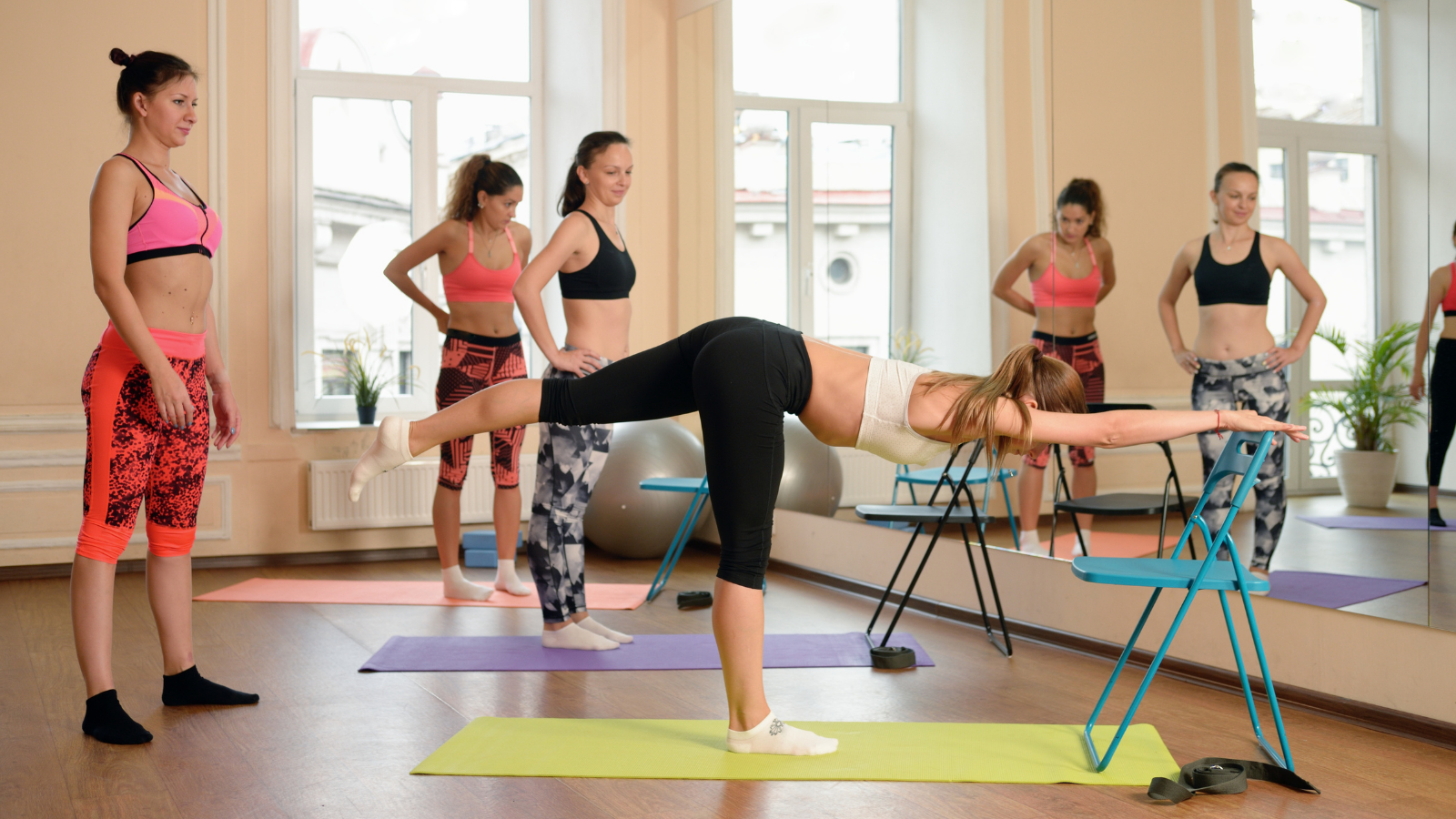 We make a big mistake in our thinking about habits when we define them as purely individual behaviors and choices. In reality, they have as much (perhaps more) to do with your social circumstances as they do with you personally. Many habits are the indirect, tremendously complex result of your social network.
We make a big mistake in our thinking about habits when we define them as purely individual behaviors and choices. In reality, they have as much (perhaps more) to do with your social circumstances as they do with you personally. Many habits are the indirect, tremendously complex result of your social network.
According to the folks who conducted the Framingham Heart Study, “When smokers kick the habit, odds are they are not alone in making the move. Instead, the decision to quit smoking often cascades through social networks, with entire clusters of spouses, friends, siblings, and co-workers giving up the habit roughly in tandem, according to a new study supported in part by the National Institutes of Health (NIH).”
The Framingham study found that if someone you didn’t even know – a friend of your friend’s friend – quit smoking, you were 9 percent more likely to quit yourself. This means that people you don’t even know influence your habits. And guess what? If your best friend becomes obese, your chances of heading that way go up 171 percent. Is that a good enough reason for you to schedule regular yoga classes with your friends?
The yoga tradition recommends Satsaunga, or “keeping good company.” Perhaps the most powerful thing you can do to change your habits is to hang out with people with good ones and encourage them in others.
2. Create Good Habits
 One of my yoga teachers said to me, “Don’t worry about your bad habits; just meditate every day and see what happens.” We had been talking about whether or not it’s okay to drink alcohol, eat meat, stay up late, and other habits yogis generally eschew. She explained that it’s not so much about steeling your will against what you should not be doing but rather paying attention to cultivating what is good for you.
One of my yoga teachers said to me, “Don’t worry about your bad habits; just meditate every day and see what happens.” We had been talking about whether or not it’s okay to drink alcohol, eat meat, stay up late, and other habits yogis generally eschew. She explained that it’s not so much about steeling your will against what you should not be doing but rather paying attention to cultivating what is good for you.
Here are a few of my faves:
-
Exercise – Do I really need to say why? The more important question is this: How does your social situation/life support this? Do you need an exercise buddy? Can you scrape your spouse off the couch to join you? How can you make this fun, easy, and something you will actually do regularly?
-
Be in Nature – Find someplace not too far from home and go there to breathe, walk, and be – twice a week.
-
Hydrate – If you use a quart-sized Ball jar, you can easily keep track, and the amount varies from person to person. I try to drink at least three in the winter (a lot in the form of herbal tea) and more in the summer, starting 30 minutes after or finishing 30 minutes before eating.
-
Eat like a real person – I’m serious! It’s much better to have hearty, healthy meals than it is to be plagued by late-night snack attacks that pack on the pounds. Smoothies and tea are great, but they do not constitute three meals a day. Remember, cultivate good habits! For example, eat a lot of steamed veggies or salad at the beginning of your meals – this will go a long way towards helping you attain a healthy weight. Don’t worry so much about what not to eat; focus on enjoying the good things.

-
Put your legs up on the wall – If I could only bottle this pose! The yogis called it “the reversing process.” It’s an amazing way to relax and to help correct a spectrum of imbalances. The benefits of regularly stimulating the relaxation response should not be underestimated, and I know of no yoga pose that does it better.
-
Get to bed by 10 pm – well, this is one I don’t always follow, but I do try hard, especially if I’m really run down, to remember how much better I feel when I’m rested. Chinese medicine folks say that every hour you sleep before midnight equals two hours. Sleep is good.
3. Visualize it, Believe it
Quantum physics has confirmed an important insight that yoga masters have understood for centuries – the mind can control matter. Allowing the mind to stray into its old patterns is simply self-defeating fatalism: “I am just a heavyset person; that’s the way my whole family is; it’s genetic” or “I am a night owl, and that’s when I do my best work and even though I’d like to sleep better, I just can’t.”
If we are really limitless, as the teachings of yoga tell us, then why do we place these deterministic, tired old restrictions on ourselves? If you are the universe, how can you simply give up and resign yourself to being a chocoholic? One way of remembering your limitlessness is to be vigilant about catching yourself in your thinking patterns.
Here’s what Patanjali said: “Vitarka Bhadane Pratipaksa Bhavanam” If a negative thought plagues you, cultivate its opposite. What is one thought that irritates you regularly? Find its opposite, see how it feels when you say it to yourself – say it over and over until you feel it until you really believe it.
4. Silence, Please
 But like Cognitive Behavioral Therapy, Patanjali’s Pratipaksa practice has its limits. This is because negative thoughts are often actually feeling patterns that are carved into the limbic brain – creating a shift with your rational front brain that percolates down into the depths of your non-verbal reptilian self may not be possible.
But like Cognitive Behavioral Therapy, Patanjali’s Pratipaksa practice has its limits. This is because negative thoughts are often actually feeling patterns that are carved into the limbic brain – creating a shift with your rational front brain that percolates down into the depths of your non-verbal reptilian self may not be possible.
But yoga offers a powerful way to shift from deeply held mindsets – meditation. Preferably twice a day, even if it’s just for 2-3 minutes upon waking and before going to sleep. It will help you connect with your Source, activate your relaxation response, and put things into perspective.
Neuroscientists mapping the brain states accessed during meditation say that meditation slows the patterns called delta waves. These patterns, similar to those activated in deep sleep, are associated with healing the body. Meditators learn to access this deep state consciously.
 Kristine Kaoverii Weber is the founder of Subtle Yoga in Ashville and Charlotte, North Carolina. She has been a student of yoga since she was introduced to it in sixth grade. Kaoverii has been teaching yoga for more than twenty years. And her work these days focuses on providing yoga teacher trainings on the 200- hour and 500-hour level. Kaoverii is the director of Sarva Health, an organization that provides holistic yoga-based trainings to enhance community health infrastructure. In particular, Kaoverii developed the first RYT 200-hour training program specifically for mental health and substance abuse treatment professionals to be offered by a major continuing education institution. She is a frequent contributor to national magazines and the author of Healing Self Massage which shows how to use massage as a complement to yoga practice to relieve stress, neck and back pain, insomnia, and anxiety.
Kristine Kaoverii Weber is the founder of Subtle Yoga in Ashville and Charlotte, North Carolina. She has been a student of yoga since she was introduced to it in sixth grade. Kaoverii has been teaching yoga for more than twenty years. And her work these days focuses on providing yoga teacher trainings on the 200- hour and 500-hour level. Kaoverii is the director of Sarva Health, an organization that provides holistic yoga-based trainings to enhance community health infrastructure. In particular, Kaoverii developed the first RYT 200-hour training program specifically for mental health and substance abuse treatment professionals to be offered by a major continuing education institution. She is a frequent contributor to national magazines and the author of Healing Self Massage which shows how to use massage as a complement to yoga practice to relieve stress, neck and back pain, insomnia, and anxiety.
Featured Courses
